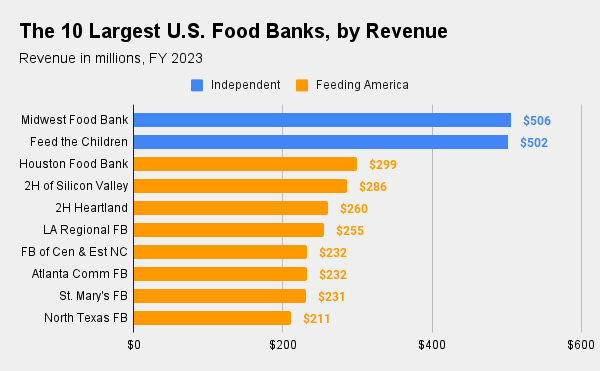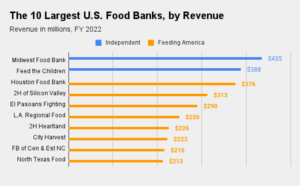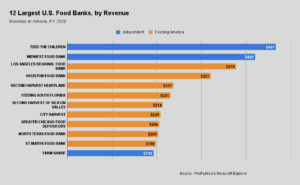Our latest look at the top 300 food banks by revenue shows that 1) the very biggest food banks are getting bigger, and 2) most food banks are relatively small.
As in years past, two food banks that operate outside of the Feeding America network emerged as the largest food banks in the country, in terms of revenue. This year, however, their pace of revenue growth far surpassed that of all other food banks.
See the full Top 300 ranking here.
The two largest food banks – Midwest Food Bank and Feed the Children – both had revenue of just over $500 million in fiscal year 2023. In contrast, no Feeding America food bank or other independent food bank had revenue that topped more than $300 million.
“Revenue” for food banks mostly consists of donations of food, with other revenue coming in from grants and individual contributions. Most of this food and cash goes right back out into the community in the form of distributed food.
While the two largest food banks added significantly to their revenue base, more than 40% of food banks in the top 300 saw some revenue loss from the previous year. That loss is in line with a stabilizing of overall food bank revenue among the top 300 food banks at nearly $16 billion for fiscal year 2023, about the same as in 2022, and down from nearly $19 billion in 2021, when the pandemic sparked an outpouring of donations and government support for food banks.
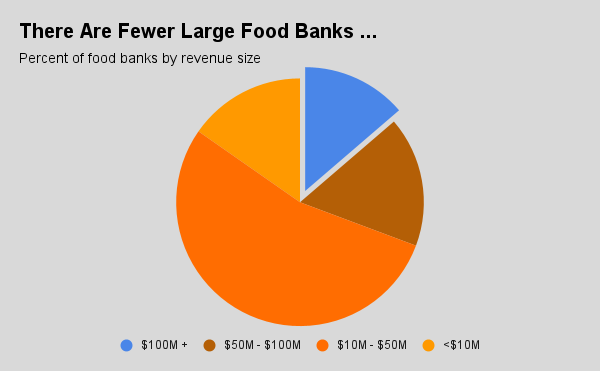 The growth of the two largest food banks stands in contrast to the relatively small size of the vast majority of food banks. Only 41 food banks of the top 300 have revenues of more than $100 million. The biggest chunk of food banks – 54% – have between $10 million and $50 million of revenue. Another 15% have less than $10 million (see chart, left).
The growth of the two largest food banks stands in contrast to the relatively small size of the vast majority of food banks. Only 41 food banks of the top 300 have revenues of more than $100 million. The biggest chunk of food banks – 54% – have between $10 million and $50 million of revenue. Another 15% have less than $10 million (see chart, left).
Despite being small in number, the 41 food banks with revenue of $100 million or more have the most revenue. They represent only 13.7% of the top 300 food banks, but have 48.3% of the revenue (see chart, below).
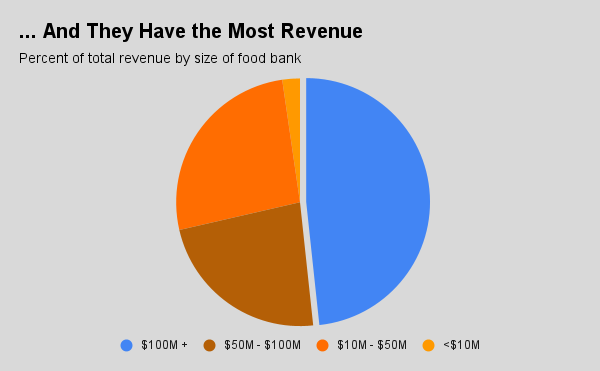 While most food banks may be on the small side, it’s worth noting that the 200 food banks of the Feeding America network plus their affiliates get support from Feeding America, which is the largest nonprofit organization in the country with $4.9 billion of revenue in fiscal 2023.
While most food banks may be on the small side, it’s worth noting that the 200 food banks of the Feeding America network plus their affiliates get support from Feeding America, which is the largest nonprofit organization in the country with $4.9 billion of revenue in fiscal 2023.
Unlike the Feeding America food banks, which operate within prescribed regions and counties, the two largest independent food banks distribute food all over the country, including for disaster relief, as well as throughout the world. Midwest Food Bank, based in Normal, Ill., has warehouse operations in eight states from Connecticut to Arizona, which distribute to more than 2,200 nonprofit agency partners. It also supplies prepackaged rice and beans to recipients in East Africa and Haiti.
Feed the Children, based in Oklahoma City, operates five distribution centers spanning Pennsylvania to Arizona, which support more than 700 agency partners across the country. It also hosts large-scale distributions known as Resource Rallies, which serve up to 800 families at a time, and partners with school districts throughout the country to operate hubs that provide food, household items and school supplies. Internationally, Feed the Children has partnerships in four African countries, three Central American countries, and the Philippines.
Travis Arnold, President and CEO of Feed the Children, noted that in the last year, the food bank realized a 77% increase in donated food items. “Our corporate partners contribute funds and products to support our mission and our community partners help us reach families in communities,” Arnold said in an interview. “Both are vital to our success.”
For many more insights into the top 300 food banks, see our interactive Tableau dashboard, which shows food banks by state, affiliation, geography, and more. With this research, Food Bank News hopes to advance knowledge and understanding of all the players working to address food insecurity in America. — Zachary Smith
Zachary Smith, a former Food Bank News intern, is Data Reporter at Cleveland.com.
Like what you’re reading?
Support Food Bank News
